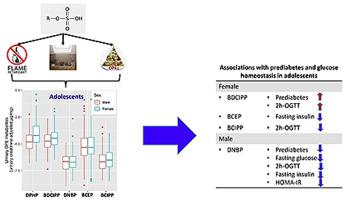Environmental Pollution ( IF 8.9 ) Pub Date : 2020-09-09 , DOI: 10.1016/j.envpol.2020.115607 Kai Luo , Ruxianguli Aimuzi , Yuqing Wang , Min Nian , Jun Zhang

|
Background
Emerging experimental evidence indicates that organophosphate esters (OPEs) can trigger glucose metabolic disorders. However, human evidence, especially in adolescents, is unavailable.
Objectives
We utilized data from the National Health and Nutrition Examination Survey 2011-2014 to evaluate whether urinary OPEs metabolites were associated with prediabetes and glucose homeostasis.
Methods
A total of 349 adolescents (12-19-year old) who provided at least 8 hours fasting blood samples, had urinary OPEs metabolites detected were included. Prediabetes was defined according to the levels of fasting plasma glucose (FPG), 2-h post oral plasma glucose (2h-OGTT) and glycated hemoglobin A1c (HbA1c). The homeostatic model assessment (HOMA-IR) and the Single Point Insulin Sensitivity Estimator (SPISE) were used to assess insulin resistance and sensitivity, respectively. Multiple binary logistic and linear regressions were used to evaluate the associations with prediabetes and indices of glucose homeostasis. The least absolute shrinkage and selection operator (LASSO) regression was used to assess the associations in a multi-pollutant context.
Results
After adjusting for covariates, certain urinary OPEs metabolites were associated with prediabetes and indices of glucose homeostasis in all adolescents. Stratified analyses by sex revealed that such associations were largely sex-dependent. In females, the multiple pollutant models showed that bis(1,3-32 dichloro-2-propyl) phosphate (BDCIPP) was positively associated with prediabetes [odds ratio (OR) = 2.51, 95%CI:1.29, 4.89, for one scaled unit increase in exposure] and 2h-OGTT (β= 0.07, 95%CI:0.01,0.12); bis(2-chloroethyl) phosphate (BCEP) was negatively associated with fasting insulin (β= -0.10, 95%CI: -0.19,-0.01) and HOMA-IR (β= -0.10, 95%CI:-0.19,-0.003); and detectable bis(1-choloro-2-propyl) phosphate (BCIPP) (>LOD vs <LOD) was inversely associated with 2h-OGTT (β= -0.11, 95%CI: -0.21,-0.02). In males, consistent inverse associations were found for detectable di-n-butyl phosphate (DNBP) with prediabetes, FPG, 2h-OGTT, fasting insulin and HOMA-IR.
Conclusion
Urinary OPEs metabolites were associated with prediabetes and indices of glucose homeostasis in adolescents. But such associations varied by sex. Future studies with multiple measurements of OPEs exposure are needed to confirm our findings.
中文翻译:

青少年尿中有机磷酯的代谢产物,葡萄糖稳态和前驱糖尿病
背景
新兴的实验证据表明,有机磷酸酯(OPE)可以引发葡萄糖代谢异常。但是,尚无人类证据,尤其是在青少年中。
目标
我们利用来自2011-2014年美国国家健康与营养调查的数据来评估尿OPE代谢物是否与糖尿病前期患者和葡萄糖体内稳态有关。
方法
包括总共349名青少年(12-19岁),他们提供了至少8小时的空腹血样,并检测到尿OPE代谢物。根据空腹血浆葡萄糖(FPG),口服血浆葡萄糖2小时(2h-OGTT)和糖化血红蛋白A1c(HbA1c)的水平定义糖尿病前期。稳态模型评估(HOMA-IR)和单点胰岛素敏感性估算器(SPISE)分别用于评估胰岛素抵抗和敏感性。使用多元二元对数和线性回归来评估与糖尿病前期和葡萄糖稳态指数之间的关系。最小绝对收缩和选择算子(LASSO)回归用于评估多污染物环境下的关联。
结果
校正协变量后,所有青少年的某些尿OPE代谢物均与糖尿病前期和葡萄糖稳态指标相关。按性别进行的分层分析显示,这种关联很大程度上取决于性别。在女性中,多种污染物模型表明,双(1,3-32二氯-2-丙基)磷酸酯(BDCIPP)与糖尿病前期呈正相关[比值比(OR)= 2.51,95%CI:1.29,4.89暴露的比例单位增加]和2h-OGTT(β= 0.07,95%CI:0.01,0.12);磷酸双(2-氯乙基)酯(BCEP)与空腹胰岛素(β= -0.10,95%CI:-0.19,-0.01)和HOMA-IR(β= -0.10,95%CI:-0.19,- 0.003);且可检测的双(1-胆固醇-2-丙基)磷酸酯(BCIPP)(> LOD vs <LOD)与2h-OGTT呈负相关(β= -0.11,95%CI:-0.21,-0.02)。在男性中
结论
尿OPE代谢物与糖尿病前期患者以及青少年的葡萄糖稳态指标相关。但是这种联系因性别而异。需要对OPEs暴露进行多次测量的未来研究来证实我们的发现。



























 京公网安备 11010802027423号
京公网安备 11010802027423号